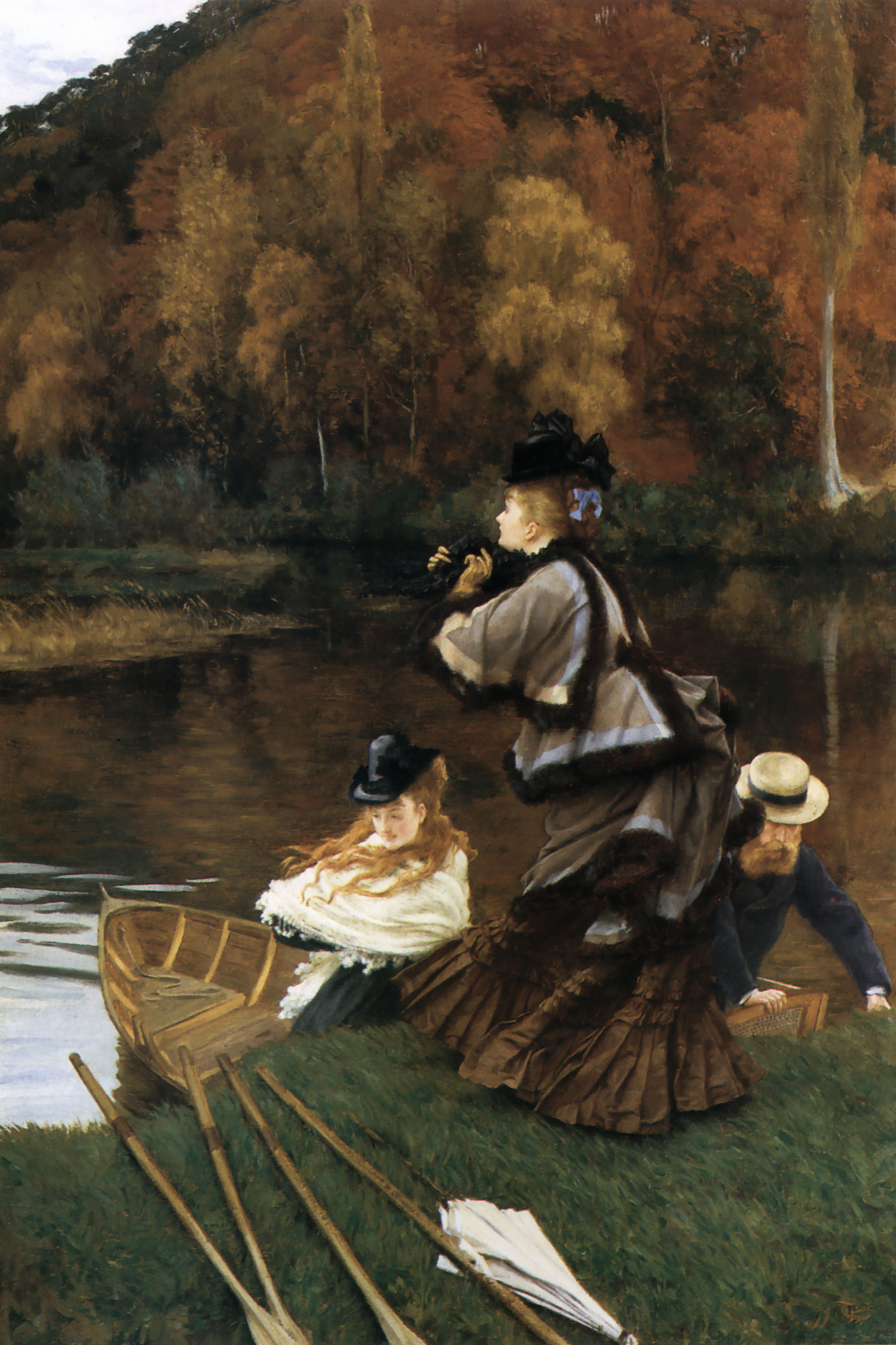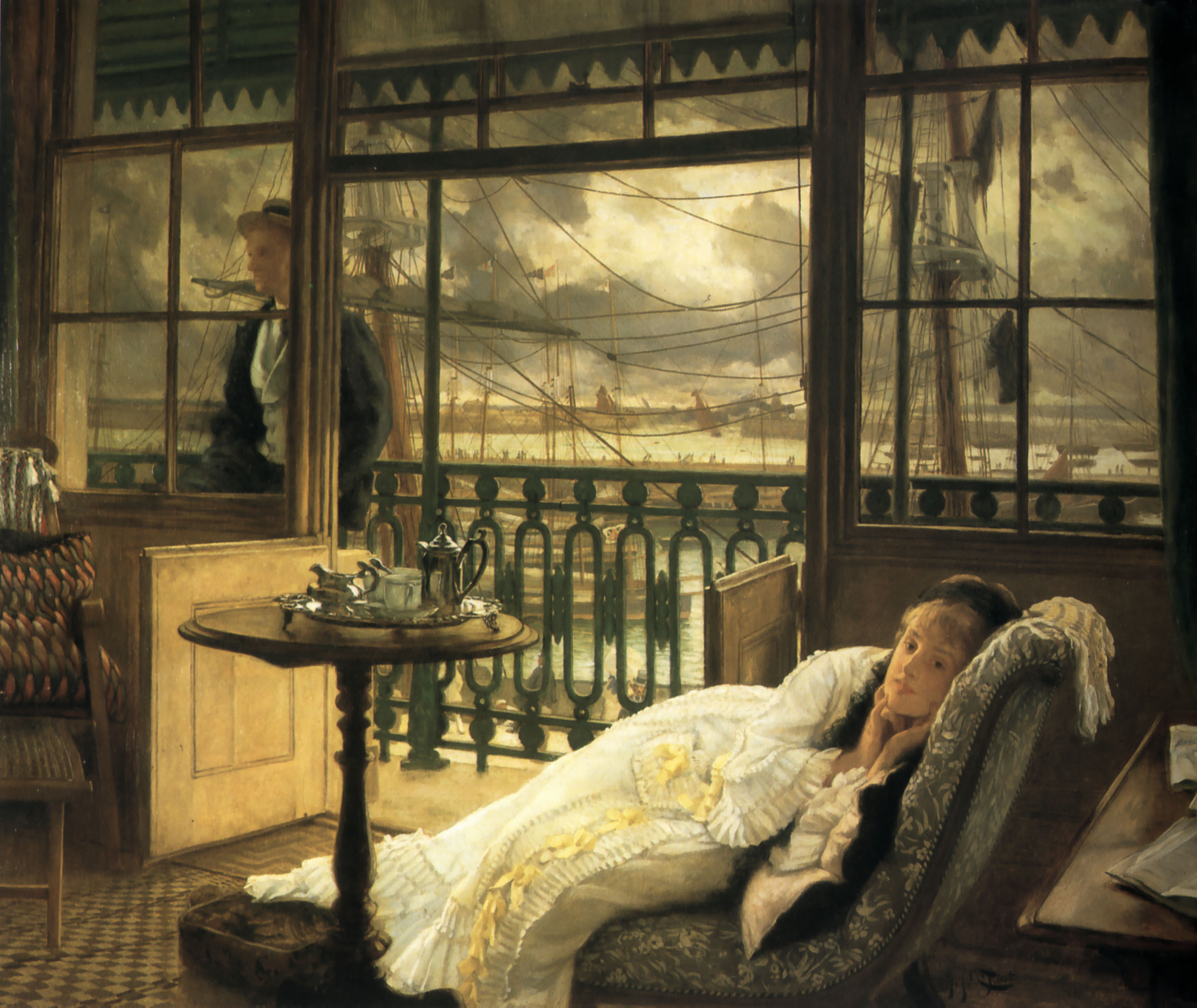To cite this article: Paquette, Lucy. “Masculine Fashion, by James Tissot: Sportsmen & Servants (1874 – 1885).” The Hammock. https://thehammocknovel.wordpress.com/2016/07/27/masculine-fashion-by-james-tissot-sportsmen-servants-1874-1885/. <Date viewed.>
Not every man that Tissot painted was an exemplar of high style; he depicted a whole cast of supporting players to his aristocrats, military figures, and fashionable males.

Still on Top (c. 1874), by James Tissot. Auckland Art Gallery Toi o Tāmaki, New Zealand. (Photo: Wikimedia.org)
The elderly male servant in Still on Top (c. 1874) wears a red liberty cap, a revolutionary symbol in France. Tissot painted this scene only three years after he had fled Paris – under some suspicion – during the French government’s suppression of the radical Paris Commune. It was a daring picture for an apparent French political refugee of the time, remaking his career in England. One has to wonder if many English servants of the day wore this style cap – or if its appearance in this work is a painterly conceit of Tissot’s. The man’s ensemble seems contrived to blend with the flags before him – his red shirt, blue long-sleeved sweater, and white canvas coveralls. And yet, because Tissot’s habit was faithfully to record the fashions of the time, we can infer the essential accuracy of the type of clothes this man would wear – i.e. the coveralls and the black leather boots with a medium heel.

Sur la Tamise (Return from Henley, also known as On the Thames, c. 1874), by James Tissot. Private Collection. (Photo: Wikipaintings.org)
These hardy men wear what we now call Henley shirts – a collarless, pullover shirt with a placket, the traditional uniform of rowers in the town of Henley-on-Thames. Their caps have black, blue and white stripes. Both the shirts and the trousers would have been cotton at this time.

Holyday (c. 1876), by James Tissot. Tate Britain, London.. (Photo: Wikimedia.org)
The cricketers in Holyday (c. 1876), in their black, red, and gold caps, are members of the famous I Zingari cricket club (which still exists, and is one of the oldest amateur cricket clubs), which played at Lord’s Cricket Ground near Tissot’s house at 17 Grove End Road, St John’s Wood, London. Incidentally, the cap colors are based on the motto, “Out of darkness, through fire, into light,” and the gold is always at the top. The men wear buff-colored lounge suits – sack coats paired with trousers cut from the same fabric, considered a casual look. The young man reclining by the ornamental pool has a red carnation boutonnière, and a large ivory-colored scarf loosely knotted at the neck of his white shirt. He wears tan and white laced spectator shoes with a low heel, just like the ones worn by the men Tissot painted in The Return from the Boating Trip (1873) and Quarreling (c. 1874-75) [see Masculine Fashion, by James Tissot: The Casual Male (1871 – 1878)].

The Warrior’s Daughter (A Convalescent, c. 1878), by James Tissot. Manchester Art Gallery, U.K. (Photo: Wikiart.org).
In The Warrior’s Daughter (A Convalescent, c. 1878, the servant pushing the wealthy, ailing gent in the bath chair is, in classic supporting player fashion, dressed to recede behind the painting’s stars. The servant’s rumpled brown coat, waistcoat, and trousers are relieved only by a white-spotted black scarf at his throat, and his unusually high-crowned brown hat with its wide maroon band halfway up. Also somewhat incongruous is the high polish on his black leather shoes.
The Letter (c. 1878), by James Tissot. National Gallery of Canada, Ottawa, Ontario. (Photo: Wikimedia.org)
The elegant manservant in the background of The Letter (c. 1878) wears livery of a black morning coat over a white shirt with a high, stand-up collar and a white tie. His tight black knee breeches blend into his black stockings and black leather shoes, which have no heels – surely allowing discreet attendance.

The Ferry (c. 1879), by James TIssot. Private Collection.
In The Ferry (. 1879), Tissot contrasts the middle-class gentleman with the ferryman. The passenger is hunched under an umbrella in his black bowler hat, black sack coat, pristine white shirt with a stand-up collar, and a tie, kid gloves and trousers in a matching light brown hue, along with black leather shoes and white spats. The supremely capable ferryman steers with glove-less hands and stays warm in his heavy black wool pea coat and dark woolen trousers. He has a natty white-and-black checked scarf at his throat and a Russian fur ushanka hat with the flaps tied up. Incidentally, Tissot’s subversive streak is evident in this painting, as few painters of the time depicted members of the middle-class as less competent than an individual below them on the social scale.

Women of Paris: The Circus Lover (also known as Amateur Circus, 1885), by James Tissot. Museum of Fine Arts, Boston, Massachusetts, U.S.A. (Photo: Wikipaintings.org)
The setting for Women of Paris: The Circus Lover (also known as Les femmes de sport, 1885) is the Molier Circus in Paris, a “high-life circus” in which the amateur performers were members of the aristocracy. The man on the trapeze wearing red is the Duc de la Rochefoucauld, one of the oldest titles of the French nobility; he was said to have “the biceps of Hercules.” Both the Duc and the man on the other trapeze wear flesh-colored leotards covering their chests, arms and legs, with brightly-colored athletic costumes, black leather belts, and colorful, laced leather athletic shoes without heels.
People of beauty and fashion attended the circus and mingled with the performers during the interval; note that the men in the audience wear gleaming silk top hats and morning coats over white shirts with stand-up collars.
Tissot’s work depicts the dress of a broad array of characters in the drama of his era, providing us with a window into his world.
Related posts:
Masculine Fashion, by James Tissot: Aristocrats (1865 – 1868)
Masculine Fashion, by James Tissot: Officers, soldiers & sailors (1868 – 1883/85)
Masculine Fashion, by James Tissot: The Casual Male (1871 – 1878)
© 2016 by Lucy Paquette. All rights reserved.
The articles published on this blog are copyrighted by Lucy Paquette. An article or any portion of it may not be reproduced in any medium or transmitted in any form, electronic or mechanical, without the author’s permission. You are welcome to cite or quote from an article provided you give full acknowledgement to the author.
 If you do not have a Kindle e-reader, you may download free Kindle reading apps for PCs, Smartphones, tablets, and the Kindle Cloud Reader to read The Hammock: A novel based on the true story of French painter James Tissot. Read reviews.
If you do not have a Kindle e-reader, you may download free Kindle reading apps for PCs, Smartphones, tablets, and the Kindle Cloud Reader to read The Hammock: A novel based on the true story of French painter James Tissot. Read reviews.
The Hammock: A novel based on the true story of French painter James Tissot, brings Tissot’s world from 1870 to 1879 alive in a story of war, art, Society glamour, love, scandal, and tragedy.
Illustrated with 17 stunning, high-resolution fine art images in full color
Courtesy of The Bridgeman Art Library
(295 pages; ISBN (ePub): 978-0-615-68267-9). See http://www.amazon.com/dp/B009P5RYVE.





